Strategies to Maximize Your Organization’s Internal IT Talent Marketplace
When it comes to IT staffing solutions, often, organizations possess a valuable asset often hidden in plain sight – their internal IT talent. Maximizing the potential of an internal IT talent marketplace can lead to enhanced collaboration, innovation, and overall organizational success. Maximizing your organization’s internal IT talent marketplace is not just about optimizing skills matching; it’s about creating a thriving ecosystem where IT professionals feel valued, empowered, and motivated to contribute their best. By implementing transparent processes, fostering a culture of continuous learning, and recognizing individual and team achievements, organizations can unleash the full potential of their internal IT talent.
This blog explores strategies to unlock the full potential of your organization’s internal IT talent marketplace, fostering a culture of continuous learning, skill utilization, and professional growth.
Building a Transparent Skills Inventory: The Foundation for Success
Why it Matters:
A transparent skills inventory lays the groundwork for effectively matching internal talent with project requirements. It enables organizations to identify and leverage the diverse skill sets within the IT workforce.
How to Implement:
Skills Mapping: Conduct comprehensive skills assessments to map the expertise of each IT professional.
Centralized Database: Create a centralized and easily accessible database to catalog individual skills, certifications, and experience.
Encouraging a Culture of Skill Development: Empowering IT Professionals
Why it Matters:
A culture of continuous skill development empowers IT professionals to stay relevant and contribute meaningfully to organizational objectives. It aligns individual growth with the organization’s evolving needs.
How to Implement:
Training Programs: Offer regular training programs to enhance technical and soft skills.
Certification Support: Provide support for obtaining relevant certifications to validate and broaden skill sets.
3. Dynamic Project Matching: Aligning Skills with Projects
Why it Matters:
Dynamic project matching ensures that IT professionals of IT consultants Virginia are assigned to projects that align with their skills and interests, fostering enthusiasm and dedication.
How to Implement:
Project Profiling: Create detailed profiles for each project, outlining required skills and expertise.
Individual Preferences: Consider the preferences and interests of IT professionals when matching them with projects.
4. Recognizing and Rewarding Contributions: Motivating Through Acknowledgment
Why it Matters:
Recognition and rewards motivate IT professionals to excel, creating a positive feedback loop that benefits both individuals and the organization.
How to Implement:
Performance Metrics: Establish clear performance metrics and recognize achievements.
Incentive Programs: Implement incentive programs such as awards, bonuses, or career advancement opportunities.
5. Facilitating Cross-Team Collaboration: Breaking Silos
Why it Matters:
Breaking down silos and fostering cross-team collaboration enables the seamless sharing of knowledge, ideas, and best practices, leading to innovation.
How to Implement:
Collaborative Platforms: Utilize collaborative platforms for knowledge sharing and project updates.
Interdepartmental Events: Organize events or workshops that bring together IT professionals from different teams.
6. Continuous Feedback Mechanism: Improving Iteratively
Why it Matters:
A continuous feedback mechanism allows organizations to iteratively improve the internal IT talent marketplace based on real-time insights and experiences.
How to Implement:
Feedback Surveys: Conduct regular feedback surveys to understand the experiences and suggestions of IT professionals.
Iterative Updates: Implement changes and updates based on feedback to enhance the effectiveness of the talent marketplace.
7. Employee Mobility Programs: Enabling Career Growth
Why it Matters:
Employee mobility programs provide opportunities for career growth within the organization, reducing turnover and retaining valuable talent.
How to Implement:
Internal Job Postings: Advertise internal job openings and opportunities for career advancement.
Clear Pathways: Define clear career pathways and progression opportunities within the organization.
8. Technology Enablement: Streamlining Processes
Why it Matters:
Leveraging technology to streamline internal talent marketplace processes enhances efficiency, making it easier for IT professionals to explore opportunities.
How to Implement:
Talent Management Software: Invest in talent management software to automate skills matching and project assignments.
User-Friendly Interfaces: Ensure user-friendly interfaces for easy navigation and engagement.
As technology evolves and organizational needs shift, the internal IT talent marketplace becomes a dynamic force that adapts and grows. By committing to the strategies outlined above, organizations can position themselves as employers of choice, attracting and retaining top IT talent while fostering a culture of innovation and collaboration that propels them toward sustained success in the ever-evolving IT landscape.
… Read More


